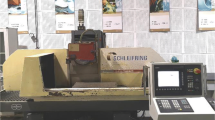Abstract
The hydroerosive grinding is one of the processes to manufacture diesel injection nozzles, being responsible for finishing injection holes. The process made use of an abrasive fluid under high pressure into these channels. Its efficiency depends on the physical properties of the abrasive fluid. Based on a previous investigation, this study verified the possibility of using a different particle size distribution of boron carbide to improve the process efficiency. All experiments were carried out in an industrial environment. The variation in process efficiency was compared with the maintenance of the viscosity along the production, and at the same time, the concentration of solids was constantly monitored. The alteration of particle size distribution was not suitable, causing an increase in the average particle size. In addition, we have verified that the concentration of solids presented a major influence on the process efficiency, being the lower the concentration, the lower the efficiency.










Similar content being viewed by others
References
Weickert M, Sommerfeld M, Teike G et al (2011) Experimental and numerical investigation of the hydroerosive grinding. Powder Technol 214:1–13
Diver C, Atkinson J, Befrui B et al (2007) Improving the geometry and quality of a micro-hole fuel injection nozzle by means of hydroerosive grinding. J Eng Manuf 221(Part B):1–9
Potz D, Christ W, Dittus B (2000) Diesel Nozzle—the determining interface between injection system and combustion chamber. Thermo-and fluid-dynamic processes in diesel engines. Springer, Berlin, pp 133–143
Fang L, Sun K, Cen Q (2007) Particle movement patterns and their prediction in abrasive flow machining. Lubr Sci 13(4):195–206
Adachi K, Hutchings IM (2003) Wear-mode mapping for the micro-scale abrasion test. Wear 255(1–6):23–29
Bulsara VH, Ahn Y, Chandrasekar S et al (1998) Mechanics of polishing. J Appl Mech 65:410–416
Coseglio MSDR, Moreira PP, Procopio HL et al (2016) Analysis of the efficiency of hydroerosive grinding without renewal of abrasive particles. J Manuf Sci Eng 138 paper 031007:1–9
BS EM 10084:2008, 2008, Case hardening steels—technical delivery conditions. BSI British Standards, London
Gao Y, Li K (2012) New models for calculating the viscosity of mixed oil. Fuel 95:431–437
Moreira PP, Grabarski MI, Pintaude G (2015) Maintenance of hydroerosive grinding process efficiency based on the abrasive fluid viscosity. In: VII Brazilian conference on rheology: paper BCR33
Humphrey J (1990) Fundamentals of fluid motion in erosion by solid particle impact. Int J Heat Fluid Flow 11(3):170–195
Moreira PP (2015) Adjust of abrasive fluid viscosity for maintenance of hydroerosive grinding efficiency. Dissertation, Federal University of Technology, Brazil
Clark HM (2002) Particle velocity and size effects in laboratory slurry erosion measurements OR… do you know what your particles are doing? Tribol Int 35(10):617–624
Messa GV, Malavasi S (2018) A CFD-based method for slurry erosion prediction. Wear 398:127–145
Acknowledgements
The authors would like to express their gratitude to Robert Bosch Ltda for providing funding as part of Project ACT 02/2013. G. Pintaude would like to thank CNPq for the financial support provided under Project 308416/2017-1.
Author information
Authors and Affiliations
Corresponding author
Additional information
Technical Editor: Márcio Bacci da Silva, Ph.D.
Publisher's Note
Springer Nature remains neutral with regard to jurisdictional claims in published maps and institutional affiliations.
Rights and permissions
About this article
Cite this article
Pintaude, G., Grabarski, M.I. & Moreira, P.P. Maintenance of hydroerosive grinding efficiency based on particle size distribution of abrasive fluid. J Braz. Soc. Mech. Sci. Eng. 41, 94 (2019). https://doi.org/10.1007/s40430-019-1594-1
Received:
Accepted:
Published:
DOI: https://doi.org/10.1007/s40430-019-1594-1



